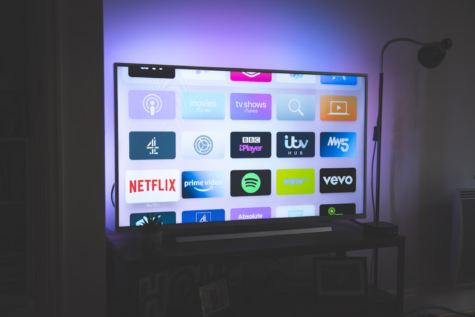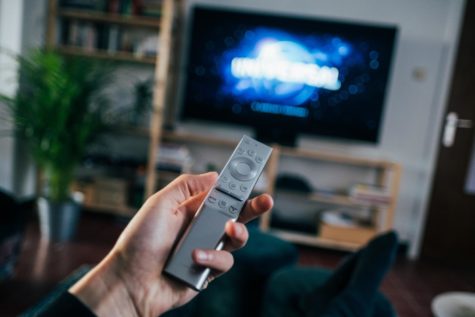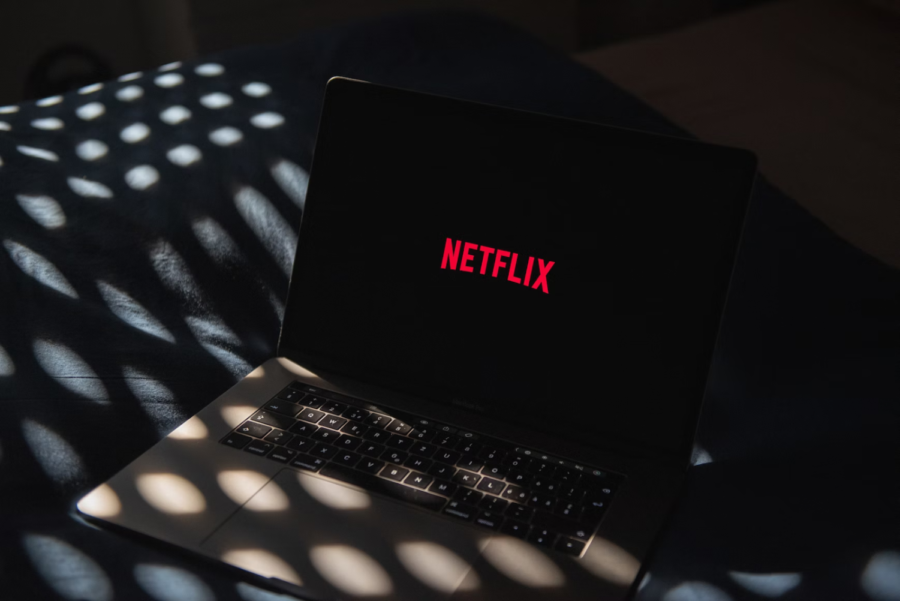Just One More Episode…The Dangers of Binge-Watching
When does a simple enjoyment — a potential coping mechanism — turn toxic?
The Netflix screen illuminates the dimly lit room. It has been four hours, but you’re not ready to leave your cocoon of blankets and the comfort that streaming provides.
Whether it is a coping mechanism or a source of bonding, binge-watching has become deeply ingrained in American culture, connecting viewers of all generations in the constant need to stream new content, wind down, or bond with friends.
The term “binge,” meaning “to soak,” emerged in English during the mid-1800s. Around World War I, “binge” came in the context of excess eating or drinking, the over-indulgence of substances being consumed by the body. “Binge-watching,” however, combining the physicality of watching with the virtual content, has been used as early as 2003 but did not enter the mainstream until roughly 2012.

One may binge movies, reality television dating shows, cooking channels, dramas, any type of media. Especially by 2023, access is unparalleled with platforms including Netflix, Hulu, HBO Max, and Amazon Prime Video competing for viewer attention. As these services capitalize on the existing market, they prioritize viewership over the state of the consumer.
Binge-watching has even expanded beyond network consumption to mainstream merchandise, with T-Shirts proudly identifying binge-watchers, lists of “The Best Shows to Binge Watch” and “all-in-one weekend-binge essentials” that include snacks, coasters, and television guides.
With this normalization comes favorable perception of time spent watching. In a 2013 study of 1500 streamers, almost three-quarters (73%) held positive feelings toward binge-watching. Streaming amounts to control, the ability for multi-episodic viewing on their own schedules especially appreciated in the uncertainty of a struggling economic climate. Viewers watch television to immerse themselves in a different world, rather than merely “zoning out.”
Understanding Binge-Watching
Dr. Yasemin Özkent of Selcuk University said, “The longer the exposure to the media, the greater its effects. Binge-watching is defined as watching two or more episodes of the same series or for at least three hours in one sitting. As digital media environments increase, media consumers are no longer just ‘viewers,’ but now ‘users’ appear as active consumers.”
Technology dependence also targets younger and more vulnerable people. Dr. Maèva Flayelle of the University of Lausanne said, “Binge-watching is a prevalent behavior among adolescents who have greater access to technology and tend to spend more time engaging with media compared to other age groups… Crucially, adolescents might be especially vulnerable to develop problematic patterns of binge-watching due to immature cognitive-control abilities. Their brain (notably areas governing self-regulation and decision-making) is still developing, which makes them more prone to impulsive behaviors and difficulty in setting limits. Moreover, adolescents already face various psychological challenges, including identity formation, peer pressure and academic stress. Problematic binge-watching can exacerbate these struggles and contribute to mental health issues.”
To teens, binge-watching can take many forms and come as a response to a range of factors. Jasper Ward ’25 explained, “I am not sure [why I watch television]–maybe as a comfort mechanism or a way of learning, or possibly a force of habit.” He watches between 5 and 10 hours of T.V. a week, which falls on the low side compared to the many teenagers who spend upwards of 20 hours watching a week.
Streaming rates have only increased, especially during the Coronavirus pandemic. According to Nielsen, the terrifying total amount of time spent weekly streaming videos increased almost 75% between 2019 and 2020.
Kathryn Wu ’26 shared, “During quarantine, I watched T.V. way more. I think I used to spend 2-8 hrs daily just binging on Netflix shows.” For the developing mind, this intense level of technology reliance – though normalized – causes strain and future issues.
Flayelle added, “Binge-watching during the pandemic exemplified how individuals adapted to the unique circumstances and sought entertainment and social connection through media consumption. It highlighted the role of streaming platforms and the communal nature of shared viewing experiences, even when physical interactions were so limited.”
Physical and Mental Health Risks of Binge-Watching
Although research in this field is new, many researchers have begun to label it as an addiction. Akin to many drugs, binge-watching causes increased production of dopamine, a neurotransmitter that releases feelings of joy, excitement, and pleasure. It is no surprise that 73% of those surveyed by Netflix reported connections between binge-watching and positive feelings. The brain craves more dopamine, increasing the desire to binge-watch. Video game addiction has been classified as a medical phenomenon for similar reasons.
Flayelle qualified, “At the moment, binge-watching is not formally recognized as an addictive behavior. However, evidence shows the existence of problematic patterns of binge-watching associated with loss of control and a range of functional impairments (e.g., sleep deprivation, decreased work performance). Factors associated with problematic binge-watching include personality traits such as high impulsivity (thus involving decreased self-control capabilities), sensation seeking and neuroticism, escapism and avoidance motivation, anxiety, depression, loneliness, peer pressure and social norms, and availability and accessibility of streaming platforms.”
Occasional binge-watching is normal. However, constant binge-watching may drastically affect health by yielding sedentary behavior, sleep problems, and an unbalanced diet.

Sedentary behavior means minimal movement tied to sitting or laying down. Between the years of 1950 and 2018, there was an 83% increase in desk jobs, with those in offices sitting more than 89% percent of the time. Sitting for prolonged periods of time increases muscle tightness and even the risk of contracting Type 2 Diabetes.
Those with preexisting health conditions also may spend more time seated due to their symptoms, potentially leading to more time watching television, which perpetuates the cycle. A 2020 study analyzed eighteen reviews on the relationship between sedentary behavior and health over a decade and found connections to depression, physical disability, and cognitive function.
Research conducted in 2021 found that people suffering from depression are typically more sedentary. The inverse may also be true: the same research suggests that sedentary behavior may be a risk factor for depression. In tandem, WebMD found a correlation between how lonely and depressed people self-report and their chances of binge-watching.
Sleep problems caused by proximity to technology, as exacerbated in those who binge watch, especially right before bed, also pose a daunting threat.
A 2015 study on restfulness observed that, from more than 2,000 children, those sleeping near a small screen had around 20 minutes less sleep than those who never slept near a small screen. Although a seemingly small number, twenty minutes can be a marked difference for one whose brain is still developing. Furthermore, people who sleep in a room with a television not only possess more screen time but shorter sleep durations.
Additionally, a study from 2016 found a correlation between high smartphone screen use and poor sleep quality. Insufficient or interrupted sleep then causes a multitude of chronic health problems from heart and kidney disease to high blood pressure to obesity and more.
These health benefits extend directly to the Bronx Science sphere. “I have lost a lot of sleep [due to television],” admitted Eleanna Curri ’26. She is only one of many students for whom technology — and streaming use — affects the body, circadian rhythms, and then focus for the rest of the day.
Binge-watching may also cause changes in diet, encouraging behaviors such as snacking or eating low nutrition meals during long periods of sitting. A 2017 review of 13 studies including more than 60,000 children found that children who ate while watching television tended to have a poorer diet — typically sugary drinks, high fat foods, and fewer fruits and vegetables — than those who did not. Poor diet connects to diabetes, heart disease, and cancer.
More of the many health problems connected to this struggle include back issues, respiratory failing, and loss of physical activity. Caused by poor posture while watching, spine weakness or curvature may cause musculoskeletal problems and back pain. Slumping also decreases respiratory function, even for healthy people. Finally, the prior mentioned sedentary behavior may limit time exercising, amplifying risk of heart disease and stroke. In fact, research by the American Heart Association has found that spending four or more hours a day watching television may increase the risk of cardiovascular disease or early death by 50 percent.
Furthermore, like any addiction, binge-watching may affect one’s goals, commitments, and satisfaction. This causes one to lose control over the time spent watching or need to increase the hours spent watching to experience the original results. When asked to stop, respondents may increase in defensiveness, irritability, and unreasonableness.
Binge-watching also enables disconnection from others, to withdraw and isolate, and the straining of relationships. “The ease of access to digital platforms has made them a powerful tool for influencing the social lives of individuals. Binge-watching triggers loneliness and social isolation as an addiction that prevents young people from socializing. These effects on life activities and psychology, when combined with other factors, have an impact on the ‘teen mental health epidemic,’” said Dr. Özkent.
Ways to Combat Binge-Watching
Strategies to counter binge-watching include incorporating limits into one’s routine, such as enforcing stricter bedtimes, restricting the number of episodes or minutes watching television, or taking regular breaks to stretch and move. Other strategies include prioritizing hobbies, like sports, purchasing healthier snacks, and completing active chores, like ironing, while watching television to reduce sedentary behavior. Even keeping lights on in the surrounding area of the screen prevents losing track of time and reduces the likelihood of binging.
There is no formal binge-watching treatment. Some believe that excessive watching represents a non-substance addiction, in the same vein as food or gambling addictions. To treat these addictions, first comes acknowledging one’s patterns. If one cannot stop, these addictive behaviors, medications such as selective serotonin reuptake inhibitors and talking therapy are recommended.
For binge-watchers with other health problems, binge-watching may quickly exacerbate these issues, and a person should speak to a doctor if concerned about their behavior and/or potential ties to other health conditions.
As a society, the normalization of media reliance has permeated our lives, with phones becoming an extension of our limbs. However, as screen time rises, we increase the difficulty of maintaining health, relationships, and external healthy coping mechanisms.
Özkent emphasized, “New media academics need to pay more attention to this new T.V. norm and guide society on its potential negative effects. Today, the concept of ‘media literacy’ has turned into ‘digital media literacy.’ It is necessary to discuss the effects of excessive monitoring within the scope of digital media literacy and to announce them to society…When individuals and parents are made aware of digital media literacy, potential negative effects will be prevented.
“Video streaming platforms [should] allow users to take a break from watching (1 hour break for your physical health; for example, you need to burn 500 calories; for your mental health, you need to take a 3-hour break for your mental health; etc.) after performing a viewing experience for a certain period of time in order to protect their mental, psychological, and social health. A service that gives alerts can be developed,” said Özkent.
We linger in a precarious moment in shaping the next generation. Will we seclude ourselves with episodes, or will we find balance in navigating the world outside?
Binge-watching also enables disconnection from others, to withdraw and isolate, and the straining of relationships. “The ease of access to digital platforms has made them a powerful tool for influencing the social lives of individuals. Binge-watching triggers loneliness and social isolation as an addiction that prevents young people from socializing. These effects on life activities and psychology, when combined with other factors, have an impact on the ‘teen mental health epidemic,’” said Dr. Yasemin Özkent of Selcuk University.
Hallel Abrams Gerber is an Editor-in-Chief for ‘The Science Survey,’ using her writing to represent a myriad of social issues and innovations, bolster...











